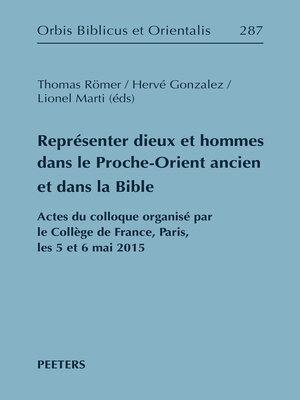Representer dieux et hommes dans le Proche-Orient ancien et dans la Bible
ebook ∣ Actes du colloque organise par le College de France, Paris, les 5 et 6 mai 2015 · Orbis Biblicus et Orientalis
By H Gonzalez

Sign up to save your library
With an OverDrive account, you can save your favorite libraries for at-a-glance information about availability. Find out more about OverDrive accounts.
Find this title in Libby, the library reading app by OverDrive.



Search for a digital library with this title
Title found at these libraries:
| Library Name | Distance |
|---|---|
| Loading... |
Quelle est la fonction des representations du divin et aussi des hommes dans le Proche-Orient ancien? Quelles sont les differentes manieres de rendre visible des dieux et quelles en sont les fonctions particulieres? Ces representations materielles et visuelles permettent-elles de mieux comprendre les cultes officiels et les cultes prives? Quel est le role des images dans le culte royal? Est-ce le roi ou tous les humains qui sont l'image des dieux? Pour quelles raisons decide-t-on d'interdire des images cultuelles? Y a-t-il des precurseurs a l'interdiction biblique dans le Proche-Orient ou ailleurs? Comment les representations des dieux et des hommes changent-elles en l'absence d'image cultuelle? Le colloque Representer dieux et hommes dans le Proche-Orient ancien et dans la Bible, qui s'est tenu les 5 et 6 mai 2015 au College de France, avait pour but d'eclairer ces questions autour de l'image, un sujet central pour l'intelligence des religions anciennes et modernes. What was the function of representing deities and also humans in the ancient Near-East? Which were the different ways of making gods visible, and the specific functions of these representations? Might these material and visual representations help us to better understand official cults, as well as private cults? What was the role of images in the royal cult? Was the king the only "image" of the gods, or could all humans fulfill this role? Why were cult images forbidden? Does the biblical prohibition have any precedent or parallel in the ancient Near-East, or elsewhere? And how do the ways of representing gods and humans change in the absence of cultic images? The conference Representing Gods and Humans in the Ancient Near-East and in the Bible, held at the College de France, Paris, on May 5-6 2015, sought to shed light on these questions surrounding the image, a critical issue for our understanding of ancient as well as modern religions.







